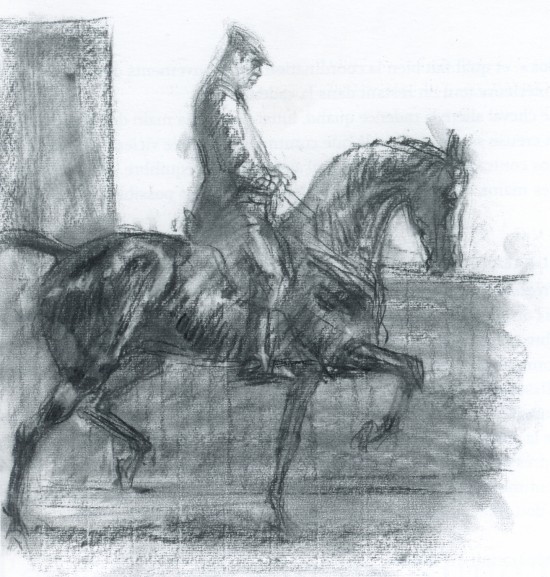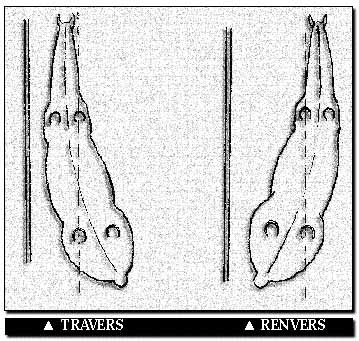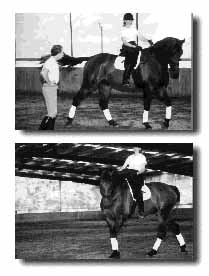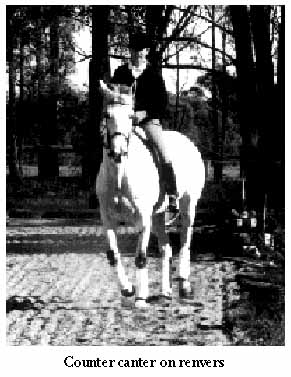Illustration by Jean Louis Sauvart – of Miguel’s early teacher, Nuno Oliveira
Through all the work we are going to do we must always be sure that the horse maintains his balance and impulsion – the elements which produce rhythm, straightness and contact.
In order to confirm and develop this balance and impulsion, I start by making transitions from the 20 metre circle to the 10 metre circle, making sure that the horse does not slow down the canter and that he keeps a jump in his stride – especially on the 10 metre circle. If he loses his balance or drops the impulsion while moving to the smaller circle, I enlarge again the circle and increase my aids in order to re-establish the qualities of balance and impulsion, that I lost. I then bring him back to the 10 metre circle, from which I continue along the arena going large and straight while paying close attention to maintaining the same rhythm in the canter. When I feel the horse becoming comfortable with this exercise, I start the counter canter work, which is a very good way to develop suppleness and straightness.At the same time, I start making transitions from canter to walk and from walk to canter. On the 10 metre circle, I do transitions to the walk and I go back to the canter on the 20 metre circle. It is very important to keep the impulsion at the walk after making a transition from the canter (we should only walk a few steps).
Our ability to maintain this impulsion will increase the quality and the ease with which we do the flying change later on. I only do the transitions to walk when the quality of the canter is good (my canter being marked by good impulsion and a correct and consistent balance). I ask for these transitions from canter to walk and from walk to canter to ensure that I have impulsion and obedience to the half halt with a steady and soft contact.
These transitions also help prepare my horse for shoulder-in at the canter, which I ask for after leaving the second corner of the short wall as I start down the long side of the arena. I bring the shoulders a little bit in from the wall (more of a shoulder-fore position) with my attention on keeping the movement very forward. In this position of shoulder-fore I slide along the wall for a few strides, and I finish the exercise by bringing the horse to the 1Om circle and asking for a transition to walk, rewarding and patting.
When the horse is comfortable with this work I can increase the number of strides and increase the angle of the horse from the wall to the position of the shoulder-in. I can then make my transition to the walk along the wall while maintaining the position of the shoulder-in (I then walk forward and straighten my horse along the wall, taking the canter again as soon as my horse is straight.)
Because the horse already knows the half-pass, travers and renvers at the trot, I normally have no problems in teaching these exercises at the canter.
Usually at the canter I start the training of the half-pass at the same time I begin training the hindquarters-in exercises, following the same progression I did at the trot. When I am doing hindquarters-in on the circle at the canter, I am very careful about controlling the hindquarters. The horse has to bring the hindquarters in while keeping the engagement. (I have to be careful that he does not start ‘dropping’ the hindquarters or ‘falling’ in to the circle.) To achieve this I make frequent transitions from the hindquarters-in to the shoulder-in on the circle in order to control his inside hind leg, returning again to the hindquarters-in position. During this exercise we have to feel the horse improving his suppleness, engagement, impulsion and collection.
I am going now to explain some transitions and combinations of exercises that I use to further develop collection and later on develop the pirouette at the canter.
I start by riding on the 20 metre circle with the hindquarters in, making transitions from the 20 metre circle to the 1O metre circle while keeping the hindquarters in. Then while on that 1O metre circle I make frequent transitions from the hindquarters-in position to a straight position (always maintaining the 1O metre circle), returning to the hindquarters-in, on that circle.
When my horse shows the ability to make these transitions from the hindquarter-in on the 1O metre circle to a straight position on the circle and then back to the hindquarters-in, this tells me that he is in balance and proves he is not just drifting in with the hindquarters.
Another exercise that I find very useful to develop collection at the canter is the renvers at the counter canter. While riding the renvers at the canter and upon reaching the middle of the long wall, I over-collect the horse and ride two or three strides of what is almost a canter on the spot.
After these two or three strides I let go again and return to the normal canter white maintaining the renvers position. When I have my horse accepting this work with ease, I do the same counter canter along the wall in the renvers position, and about 15 metres before the corner I take my horse off the wall, pointing towards the middle of the next short wall. (Leaving the wall just past B or E, and riding towards A or C.) I then ride a half circle with the hindquarters in and I return to the same long wall at the true canter, riding forward along that wall in the travers position. Later on, instead of riding a half circle with the hindquarters in after leaving the wall, I will make a half pirouette.
To train the half pirouette I leave the wall and begin the half circle with the hindquarters in, but progressively I decrease the size of the half circle until I have achieved the pirouette.
Returning to the long wall while riding in the travers position helps the horse to keep his balance with that degree of collection. And now when I reach the end of the long wall (in the travers position) I can ride another half circle with the hindquarters in, followed by a sharp half pass back to the wall. Once returning to the wall I can slide along the wall again at a counter canter in the renvers position.
This exercise (renvers – half circle with the hindquarters in – travers – half circle with the hindquarters in – renvers again at the counter canter) is a very useful gymnastic exercise that develops the qualities the horse has to have to do the pirouette at the canter. When we achieve the pirouette, we achieve the highest degree of collection that we will ask for at the canter.
While thinking about this, it is very important not to become confused about the difference between engagement and collection. Engagement is one particular quality of collection.
Engagement by itself does not mean collection. When the horse gallops, or when the horse extends the trot, he engages to a very high degree, and yet, he is not collected. I can make a very good transition from trot to walk without needing collection – needing only engagement. (Unless, of course, I am making the transition from the collected trot to the collected walk.) When ridden in collection, the horse takes the weight on his hindquarters, carries the weight on his hindquarters, and pushes the weight more upwards. It is this upward direction of his movement that shows the collection. If the horse pushes the weight much more forward than upward – for example, when he gallops – it is certain that he is extremely engaged, but he is definitely not collected. This means of course that engagement is one very important element of collection, but not its only defining characteristic. The way we use engagement – forward vs. upward- is what determines whether we are showing collection.






This article is SO good!